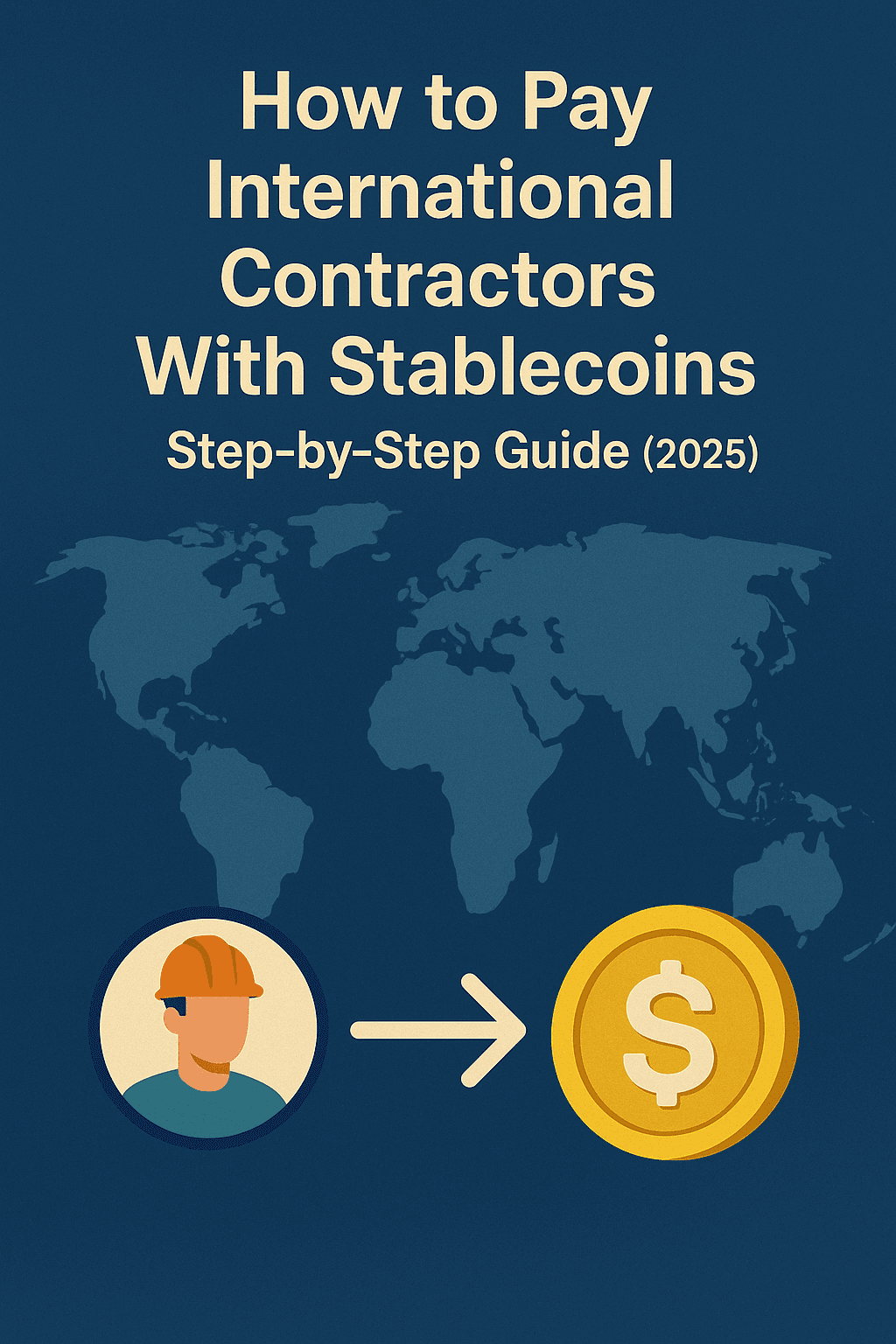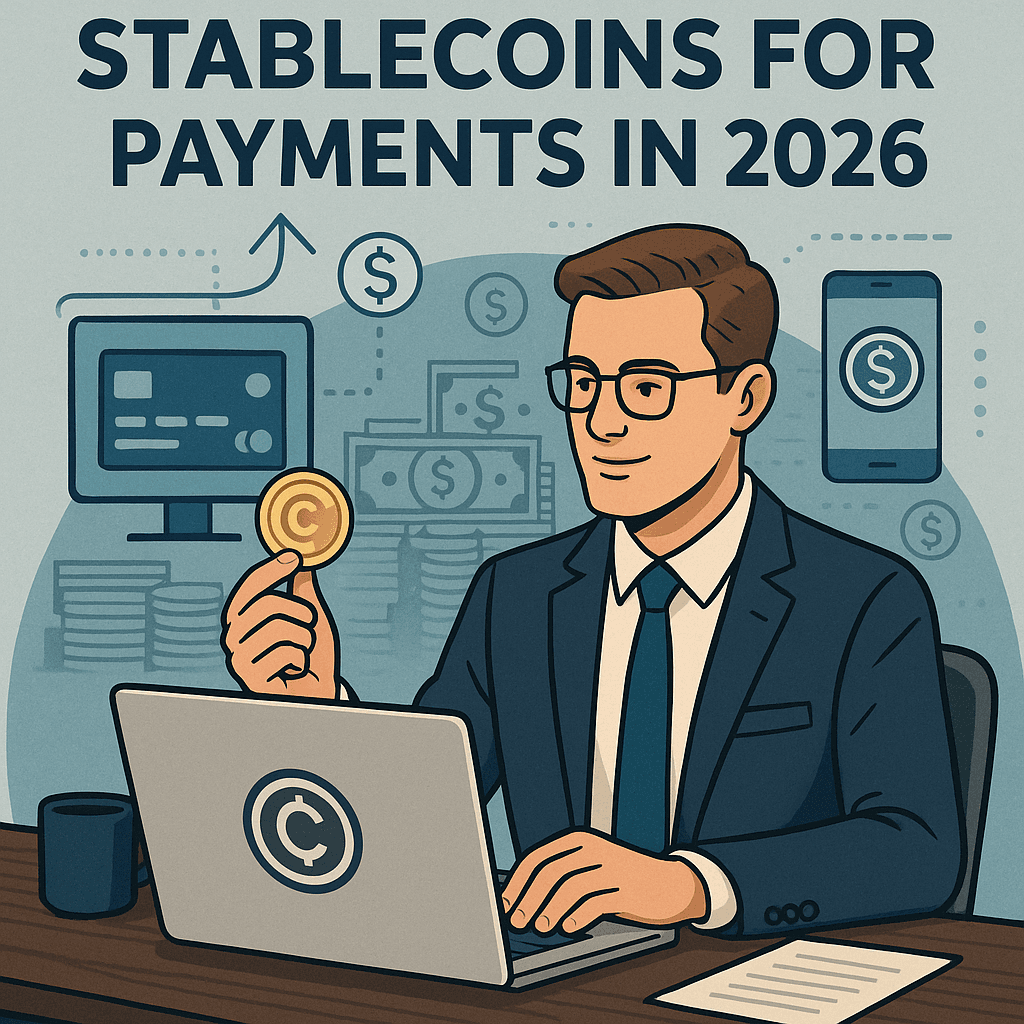Paying international contractors just got 98% cheaper and 1000x faster. With 25% of companies worldwide now using crypto payroll and stablecoin volumes hitting $710 billion monthly, smart businesses are ditching expensive wire transfers for stablecoin payments.
This guide shows you exactly how to set up stablecoin contractor payments, stay compliant, and start saving thousands in fees immediately.
Quick Answer: Choose USDC, set up a compliant platform, collect contractor KYC forms, execute payments through secure wallets, maintain records. Total setup time: 2-4 weeks. Fee savings: 95-98% vs traditional methods.
Why Pay Contractors With Stablecoins?
The Wire Transfer Problem
Traditional international contractor payments are expensive and slow:
Wire fees: $40-50 per transfer
FX markups: 2-4% on currency conversion
Total cost: $160-300 on a $5,000 payment (3-6%)
Settlement time: 3-5 business days
Failure rate: 14% require costly corrections
The Stablecoin Solution
Stablecoins (cryptocurrency pegged to USD) eliminate these problems:
Traditional Wire | Stablecoin Payment |
$200-300 fees | $0.50-2.00 fees |
3-5 days settlement | 2-5 minutes |
Banking hours only | 24/7/365 |
High failure rate | Near 100% success |
Real savings: Companies with $100K monthly contractor spend save $40K-82K annually by switching to stablecoins.
Step 1: Choose the Right Stablecoin
Best Stablecoins for Payroll (2025 Data)
USDC (USD Coin) - Recommended
63% market share in crypto payroll
Regulatory compliant and institutionally backed
Full reserve transparency with monthly audits
Supported on all major blockchains
USDT (Tether) - Alternative
28.6% market share
Higher global liquidity
Better for emerging markets
Some regulatory uncertainty
Start with USDC for maximum compliance and institutional acceptance.
Step 2: Set Up Your Payment Infrastructure
Option A: Use a Stablecoin Payroll Platform (Recommended)
Best Platforms:
Rise: $50/contractor/month, automatic compliance
Toku: Full global payroll with 100+ country compliance
Remote: Stablecoin payouts to 70+ countries
Dynamic: Custom infrastructure for larger organizations
Pros: Built-in compliance, contractor onboarding, tax reporting
Cons: Monthly fees, limited customization
Option B: Build Custom Infrastructure
For companies with 500+ contractors:
Wallet management with multi-signature security
Compliance engine for KYC/AML requirements
Payment orchestration across multiple blockchains
Automated reporting for tax purposes
Option C: Programmable Payment Solutions
Advanced platforms like RebelFi offer yield-generating infrastructure:
Earn 6-9% APY on payroll funds while awaiting distribution
Pull-based payments eliminate failed transfers
Smart escrow with milestone-based releases
Cross-chain support for contractor flexibility
Step 3: Handle Legal Compliance
Tax Requirements
For US Companies:
Collect Form W-8BEN from individual contractors
Collect Form W-8BEN-E from business entities
No withholding required for most international payments
Starting 2025: Form 1099 required for $10K+ stablecoin payments
For Contractors:
Must report stablecoin payments as income
Tax rates vary: Japan (55%), Germany (0% after 1 year)
Recommend contractors consult local tax professionals
Worker Classification
Key Points:
Payment method doesn't affect contractor vs employee status
Maintain genuine independent contractor relationships
Different countries have different classification rules
Misclassification can result in penalties and back pay
Best Practice: Consult legal experts in contractor jurisdictions before starting.
Step 4: Execute Your First Payment
Contractor Onboarding Checklist
Required Information:
[ ] Government-issued photo ID
[ ] Proof of address (utility bill/bank statement)
[ ] Tax forms (W-8BEN or W-8BEN-E)
[ ] Digital wallet address
[ ] Signed contractor agreement
Payment Execution Process
Verify contractor setup: All documents collected and verified
Calculate payment: USD amount per contractor agreement
Send test payment: Small amount ($10-50) to confirm receipt
Execute full payment: Send stablecoins to contractor wallet
Confirm receipt: Contractor acknowledges payment received
Document transaction: Record for tax and compliance purposes
Security Best Practices
Multi-signature wallets for amounts over $10,000
Address verification before every payment
Transaction limits to prevent large errors
Regular audits of wallet security
Step 5: Scale and Optimize
Automation Features
Recurring Payments:
Set up monthly/bi-weekly automatic payments
Implement approval workflows for varying amounts
Create exception handling for failed transactions
Bulk Processing:
Process multiple contractors in single transactions
Upload CSV files for batch payments
Optimize network fees through timing
Advanced Features
Yield Generation: Instead of letting payroll funds sit idle earning 0%, modern infrastructure generates 6-9% APY while funds await contractor claims.
Example: $100K monthly payroll earning 7% APY for 5 days average claim time = $291 monthly additional revenue
Smart Escrow:
Milestone payments: Automatic release upon deliverable completion
Dispute resolution: Built-in arbitration mechanisms
Cancellation windows: Allow payment reversals before claims
Cost Comparison: Real Numbers
$5,000 International Payment Example
Traditional Wire Transfer:
Wire fee: $45
FX markup (3%): $150
Intermediary fees: $25
Total cost: $220 (4.4%)
Stablecoin Payment:
Network fee: $1.50
Platform fee: $5.00
No FX markup: $0
Total cost: $6.50 (0.13%)
Savings: $213.50 per payment (97% reduction)
Annual Savings Calculator
For 50 contractors paid $5,000 monthly:
Traditional cost: $132,000/year in fees
Stablecoin cost: $3,900/year in fees
Annual savings: $128,100
ROI: Implementation costs typically paid back within 2-6 months.
Common Challenges and Solutions
Challenge 1: Contractor Education
Problem: Many contractors unfamiliar with crypto wallets
Solution:
Provide step-by-step wallet setup guides
Offer customer support during onboarding
Start with small test payments
Consider hybrid payment options
Challenge 2: Regulatory Uncertainty
Problem: Evolving crypto regulations create compliance concerns
Solution:
Work with crypto-specialized legal counsel
Use compliance-first platforms
Maintain detailed transaction records
Stay updated on regulatory changes
Challenge 3: Accounting Integration
Problem: Stablecoins don't integrate with traditional accounting systems
Solution:
Use platforms with accounting software integrations
Implement automated reconciliation tools
Maintain parallel records for traditional reporting
Regional Adoption Patterns
Latin America (High Adoption)
Driver: Protection against currency inflation
Adoption rate: 40-67% in high-inflation countries
Preferred: USDT for liquidity, USDC for stability
Southeast Asia (Efficiency Focus)
Driver: Cross-border payment efficiency
Adoption rate: 22-34% among tech professionals
Preferred: USDC for compliance
Africa (Financial Inclusion)
Driver: Access to global payment systems
Adoption rate: 29-45% where banking is limited
Preferred: Low-cost stablecoins on efficient networks
Future Outlook
Regulatory Developments
GENIUS Act (US):
Signed July 2025, provides federal stablecoin framework
Banks can custody stablecoins without balance sheet impact
Creates partnership opportunities between banks and infrastructure providers
Global Trends:
EU's MiCA regulation provides European clarity
Increasing central bank digital currency (CBDC) integration
Growing institutional adoption across Fortune 500
Technology Evolution
Next 2-3 Years:
AI-driven payment optimization
Cross-chain interoperability improvements
Privacy-preserving compliance solutions
Native yield-generating stablecoins
Market Predictions:
2025: 25% → 40% company adoption
2027: 40% → 65% mainstream adoption
2030: 80%+ standard practice
Implementation Checklist
Week 1-2: Planning and Setup
[ ] Choose stablecoin (recommend USDC)
[ ] Select platform or build infrastructure
[ ] Conduct legal/compliance review
[ ] Identify pilot group of 5-10 contractors
Week 3-4: Initial Deployment
[ ] Set up wallets and security protocols
[ ] Create contractor onboarding process
[ ] Train internal team on procedures
[ ] Execute first test payments
Month 2-3: Scale and Optimize
[ ] Expand to more contractors
[ ] Implement automated workflows
[ ] Integrate with accounting systems
[ ] Add advanced features (yield, escrow)
Frequently Asked Questions
Q: Is this legal in the United States?
A: Yes, the GENIUS Act provides clear federal framework. Collect standard contractor tax forms and maintain proper records.
Q: What if contractors don't want crypto?
A: Many platforms offer hybrid solutions - contractors receive crypto but can instantly convert to their local bank account.
Q: How secure are stablecoin payments?
A: When implemented properly, more secure than traditional methods. Use multi-signature wallets and follow security best practices.
Q: What about taxes?
A: Same tax rules as traditional contractor payments. Stablecoins are treated as property by IRS but standard contractor rules apply.
Q: Which countries restrict stablecoins?
A: Most countries allow stablecoin use. China and India have some restrictions. Check local regulations before implementation.
Conclusion
Stablecoin contractor payments offer dramatic cost savings (95-98%), instant settlement, and global accessibility that traditional methods simply can't match. With 25% of companies already adopting crypto payroll and clear regulatory frameworks emerging, the question isn't whether this transformation will happen, it's whether you'll lead it or follow it.
The numbers are compelling:
Immediate cost savings: $100K+ annually for most companies
Operational efficiency: Minutes instead of days for payments
Global reach: Access previously unreachable contractor markets
Future-ready: Position for the programmable money economy
Next Steps:
Calculate your potential savings using current contractor payment volumes
Choose a platform based on your company size and needs
Start with a pilot of willing contractors
Scale gradually as comfort and expertise grow
The technology exists today to make contractor payments profitable instead of costly. Companies implementing yield-generating stablecoin infrastructure are already earning 6-9% returns on payroll funds while providing faster, cheaper payments to contractors.
Ready to transform your contractor payments?
The competitive advantages of early adoption compound quickly, start your implementation today.
Modern infrastructure like RebelFi's programmable payment systems enable companies to earn yield on payroll funds while providing contractors with pull-based payments that eliminate failed transfers. Transform your payment processing from a cost center into a profit center.



